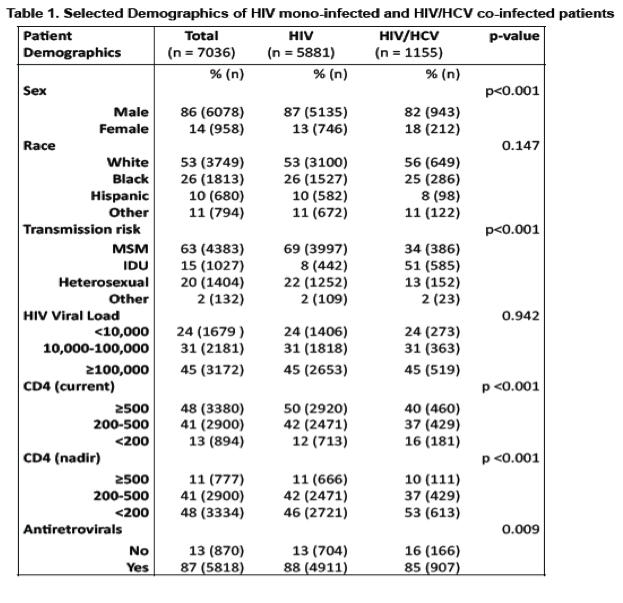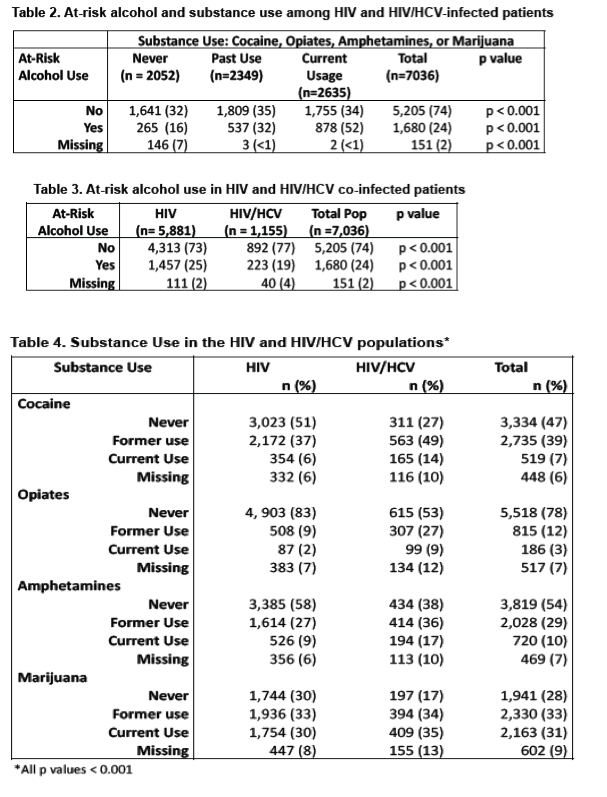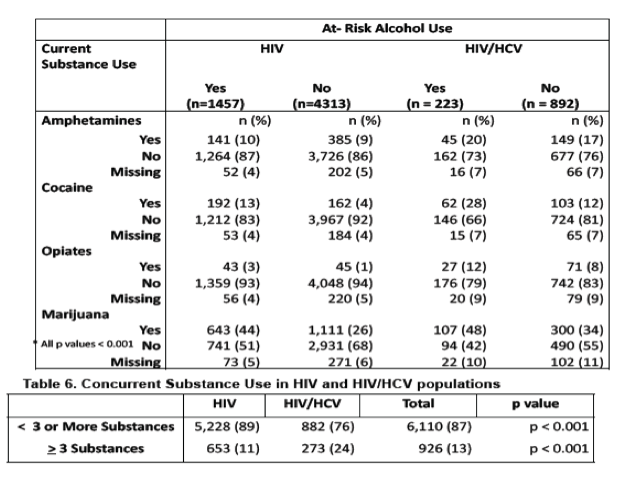 |
 |
 |
| |
Current Alcohol and Substance Use in HIV-infected and HIV/HCV-co-infected Patients in Routine Clinical Care across the U.S.
|
| |
| |
Reported by Jules Levin
IDSA Oct 2-6 2013 San Francisco, CA
JC Ling1, C Rodriguez1, HN Kim1, MJ Mimiaga2, KH Mayer3, JO Merrill1, DW Pantalone4, G Chander5, B McCaul5, H Hutton5, KL Cropsey6, MJ Mugavero6, KA Christopoulos7, WC Mathews8, GA Burkholder6, MS Saag6, MM Kitahata1 & HM Crane1 for the CNICS (CFAR Network of Integrated Clinical Systems) Cohort
1University of Washington, 2Harvard Medical School/Massachusetts General Hospital, 3The Fenway Institute, Fenway Community Health, 4University of Massachusetts, 5Johns Hopkins University, 6University of Alabama, 7University of California, San Francisco, 8University of California, San Diego
from Jules: in this study, 14% of HCV/HIV connected patients currently use cocaine (table 4), 9% opiates, 17% amphetamines, 35% marijuana. Current use of these drugs was less among HIV+ compared to connected: 6% cocaine, 2% opiates, 9% amphetamines, 30% marijuana.
CONCLUSIONS
Patterns of substance use differ among HIV mono- and connected patients. These findings demonstrate the importance of evaluating individual substances, and distinguishing between current and past use.
While at-risk alcohol use was lower among co-infected patients, 1 in 5 co-infected patients in clinical care reported current at-risk alcohol use.
Greater focus on at-risk alcohol, and concurrent drug use, and additional targeted resources for addiction treatment/interventions are needed.
BACKGROUND
· Little is known about how prevalence and patterns of alcohol and substance use differ among HIV-mono-infected and HIV/HCV-co-infected patients in the current treatment era
· Most prior studies were often small or did not distinguish between current and past use, or examine individual illicit substances
METHODS
· CNICS patients completed a touch-screen-based assessment including alcohol and substance use as part of clinical care.
· The most recent assessment data (from 5 sites: Seattle, Boston, Birmingham, San Diego, San Francisco) was used to measure substance use, including current at-risk alcohol use, amphetamine/crystal, cocaine/crack, heroin/opiate, or marijuana use, and assess patterns of concurrent substance use in HIV mono-infected and co-infected patients, using chi-squared tests.
· At-risk alcohol use was defined as those who had a score > 4 for men and > 3 for women as measured by the AUDIT-C
(Alcohol Use Disorders Identification Test Consumption).
RESULTS
· Alcohol and substance use were examined among 5881 HIV mono-infected and 1155 HIV/HCV co-infected patients
· 24% of HIV-infected patients from multiple sites across the U.S. reported at-risk alcohol use; 52% of these also reported concurrent substance use (Table 2)
Current substance use other than alcohol was higher among those with at-risk alcohol use compared to those without (52 vs. 34%, p < 0.01), with prevalence more than double for all 4 illicit drug classes (Table 2)
At-risk alcohol use was lower in the HIV/HCV population compared to the HIV mono-infected population (19% vs. 25%, p < 0.01) (Table 3)
Current substance use was significantly higher in connected patients compared to mono-infected patients for all drug classes (amphetamine, cocaine, opiate, and marijuana use) (p values all < 0.01) (Table 4)
Although more co-infected patients reported current drug usage compared to mono-infected patients (56% vs 40%,
p < 0.01), they also reported a higher prevalence of former drug use
The HIV/HCV population that reported at-risk alcohol use also reported increased substance use for all four drug classes compared to the mono-infected population (Table 5)
Co-infected patients were also more likely to report 3 or more concurrent drugs (Table 6)
Patient demographics in Table 1 immediately below report 82% of connected were men, 18% women. 56% white, 25% black, 8% hispanic. 34% MSM, 51% IDU, 13% heterosexual. 24% had viral load <10,000 - 31% 10,000-100,000 - and 45% >100,000. 16% had <200 CD4, 40% >500 & 37% 200-500. 53% had CD4 nadir <200, 37% 200-500 & 10% >500. 85% were taking ARTs.



|
| |
|
 |
 |
|
|